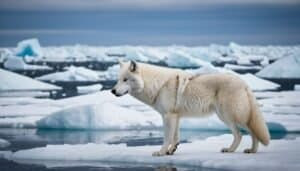Introduction
Protected areas play a crucial role in the conservation of Arctic wolves by providing a safe habitat and protecting them from various threats
This article will explore the importance of these areas, the specific conservation measures implemented, and the success stories of Arctic wolf conservation. We will also discuss the role of local communities, the impact of climate change, and the challenges faced in managing these protected areas
Importance of Protected Areas for Arctic Wolves
Protected areas are critical for the conservation of Arctic wolves, providing them with a safe habitat and shielding them from numerous threats. This section delves into the benefits these areas offer, the specific conservation measures in place, and highlights successful case studies
Additionally, we will discuss the importance of monitoring and research within these protected environments
Benefits of Protected Areas for Arctic Wolves
Protected areas offer numerous benefits for Arctic wolves, ensuring their survival and promoting a stable ecosystem. These benefits include:
Habitat Preservation: Protected areas safeguard large tracts of land, preserving the natural habitats of Arctic wolves. This preservation is vital as it prevents habitat fragmentation, which can lead to isolated populations and reduced genetic diversity
Protection from Human Activities: These areas restrict human activities such as hunting, mining, and industrial development, which can have detrimental effects on Arctic wolf populations. By limiting human interference, protected areas ensure a safer environment for these wolves
Prey Availability: Arctic wolves rely on a stable prey population for sustenance. Protected areas help maintain the populations of prey species such as caribou and muskoxen, ensuring that Arctic wolves have a reliable food source
Ecosystem Balance: By protecting the habitats of Arctic wolves and other wildlife, protected areas contribute to the overall health and balance of the ecosystem. This balance is crucial for the long-term survival of Arctic wolves and other species within the region
Specific Conservation Measures in Protected Areas
Protected areas implement various conservation measures to ensure the survival of Arctic wolves. These measures include:
Anti-Poaching Efforts: Stringent anti-poaching laws and regular patrols are established to prevent illegal hunting of Arctic wolves and their prey. These efforts are crucial in maintaining wolf populations and preventing their decline
Habitat Restoration: In areas where habitats have been degraded, efforts are made to restore them to their natural state. This includes reforestation, controlling invasive species, and ensuring that water sources are clean and abundant
Wildlife Corridors: Establishing wildlife corridors within and between protected areas allows Arctic wolves to roam freely and access different parts of their habitat without encountering human-made barriers. This connectivity is vital for genetic diversity and healthy populations
Research and Monitoring: Continuous research and monitoring of Arctic wolf populations help track their health, behavior, and numbers. This data is essential for making informed conservation decisions and adjusting strategies as needed
Case Studies of Successful Arctic Wolf Conservation
Several case studies highlight the success of protected areas in conserving Arctic wolves:
The Canadian Arctic Archipelago: This region has numerous protected areas that have successfully maintained stable Arctic wolf populations. Strict regulations and active conservation measures have ensured minimal human interference and healthy ecosystems
Greenland National Park: The world’s largest national park in Greenland provides a vast protected habitat for Arctic wolves. The park’s remote location and stringent protections have resulted in thriving wolf populations
Wrangel Island, Russia: Wrangel Island is a UNESCO World Heritage site with strict conservation laws. Arctic wolves on the island benefit from a well-preserved ecosystem, abundant prey, and minimal human activity
Monitoring and Research in Protected Areas
Monitoring and research are fundamental aspects of conservation in protected areas. These activities include:
Population Surveys: Regular surveys are conducted to estimate Arctic wolf populations and monitor changes over time. These surveys help identify trends and potential threats to wolf populations
Behavioral Studies: Understanding the behavior of Arctic wolves, such as their hunting patterns, social structures, and migration routes, is crucial for effective conservation. Behavioral studies provide insights that inform management practices
Genetic Research: Genetic research helps assess the health and diversity of Arctic wolf populations. Maintaining genetic diversity is essential for the long-term survival of the species, as it enhances their ability to adapt to environmental changes
Climate Impact Studies: Researching the impact of climate change on Arctic wolves and their habitats helps predict future challenges and develop strategies to mitigate adverse effects
Threats Mitigated by Protected Areas
Protected areas are essential in mitigating various threats to Arctic wolves, ensuring their survival in the harsh Arctic environment. This section will explore how these areas address both natural and human-induced threats and the importance of monitoring and research within protected zones
Natural Threats Addressed by Protected Areas
Protected areas help mitigate several natural threats that Arctic wolves face:
Habitat Loss and Degradation: Natural events such as wildfires, extreme weather conditions, and climate change can lead to habitat loss and degradation. Protected areas actively manage and restore habitats to maintain the natural environment necessary for Arctic wolves
Prey Population Fluctuations: The availability of prey is crucial for the survival of Arctic wolves. Protected areas ensure that prey populations such as caribou and muskoxen are maintained through habitat preservation and restoration efforts. This stability in prey availability helps mitigate the risk of food shortages
Disease Control: Protected areas implement measures to monitor and control diseases that could affect Arctic wolves and their prey. Regular health checks and vaccinations for prey species help prevent the spread of diseases that could decimate wolf populations
Human-Induced Threats Addressed by Protected Areas
Human activities pose significant threats to Arctic wolves, but protected areas provide a refuge from these dangers:
Hunting and Poaching: Illegal hunting and poaching are major threats to Arctic wolves. Protected areas enforce strict anti-poaching laws and conduct regular patrols to prevent illegal activities. These efforts are crucial in protecting wolf populations from human exploitation
Industrial Development: Industrial activities such as mining, oil drilling, and infrastructure development can destroy habitats and disrupt ecosystems. Protected areas restrict such activities, ensuring that the natural habitat of Arctic wolves remains undisturbed
Pollution: Pollution from industrial activities and human settlements can contaminate water sources and degrade habitats. Protected areas regulate activities to minimize pollution and maintain clean environments for Arctic wolves and other wildlife
Role of Local Communities and Climate Change
Local communities and climate change significantly impact the effectiveness of protected areas in conserving Arctic wolves
This section will examine how community involvement enhances conservation efforts, the effects of climate change on protected areas, and the challenges faced in managing these areas
Community Involvement in Protected Areas
Local communities play a crucial role in the success of protected areas for Arctic wolf conservation:
Community Stewardship: Local communities often serve as stewards of protected areas. By participating in conservation activities and promoting sustainable practices, they help ensure the protection of Arctic wolves and their habitat
Education and Awareness: Educating local communities about the importance of Arctic wolf conservation fosters a sense of responsibility and encourages participation in conservation efforts. Awareness campaigns and educational programs help communities understand the ecological significance of Arctic wolves
Collaboration and Partnerships: Protected areas benefit from partnerships with local communities. Collaborative efforts, such as co-management agreements, involve communities in decision-making processes and leverage their traditional knowledge for effective conservation strategies
Economic Incentives: Providing economic incentives to local communities through ecotourism and sustainable resource use can promote conservation. By linking economic benefits to the preservation of protected areas, communities are more likely to support and engage in conservation efforts
Impact of Climate Change on Protected Areas
Climate change poses significant challenges to the conservation of Arctic wolves within protected areas:
Habitat Alteration: Rising temperatures and changing weather patterns can alter Arctic habitats, affecting the availability of prey and suitable living conditions for Arctic wolves. Melting ice and thawing permafrost disrupt the ecosystems on which these wolves depend
Prey Dynamics: Climate change affects the distribution and abundance of prey species. For example, changes in vegetation due to warming temperatures can influence the migration patterns and population dynamics of caribou and muskoxen, impacting the food supply for Arctic wolves
Increased Human Activity: As previously inaccessible areas become reachable due to melting ice, human activities such as shipping, oil exploration, and tourism are likely to increase. These activities pose additional threats to the already vulnerable Arctic wolf populations
Health and Disease: Climate change can facilitate the spread of diseases and parasites that were previously limited by cold temperatures. The increased prevalence of diseases can threaten the health of Arctic wolves and their prey
Challenges in Managing Protected Areas
Managing protected areas for the conservation of Arctic wolves involves several challenges:
Resource Allocation: Limited financial and human resources can hinder effective management. Ensuring adequate funding and staffing for protected areas is essential for implementing and maintaining conservation measures
Balancing Conservation and Development: Striking a balance between conservation goals and the development needs of local communities and industries is a complex challenge. Finding ways to achieve sustainable development without compromising conservation efforts is crucial
Monitoring and Enforcement: Ensuring compliance with conservation regulations requires robust monitoring and enforcement mechanisms. Poaching, illegal logging, and other activities must be effectively controlled to protect Arctic wolves and their habitat
Climate Change Adaptation: Developing and implementing strategies to adapt to the impacts of climate change is essential. This includes habitat restoration, creating climate-resilient ecosystems, and enhancing the connectivity of protected areas to allow species to move in response to changing conditions
Local communities and climate change significantly influence the conservation of Arctic wolves within protected areas. By fostering community involvement, addressing climate change impacts, and overcoming management challenges, we can enhance the effectiveness of protected areas in safeguarding these iconic predators
Conclusion
Protected areas play a pivotal role in the conservation of Arctic wolves, providing essential habitats, mitigating threats, and ensuring the overall health of ecosystems
These areas offer numerous benefits, from habitat preservation to protection from human activities. Specific conservation measures, such as anti-poaching efforts, habitat restoration, and wildlife corridors, are crucial for maintaining stable wolf populations
Furthermore, protected areas help mitigate both natural and human-induced threats, ensuring a safer environment for Arctic wolves. Continuous monitoring and research are vital to adapt conservation strategies and address emerging threats effectively
The involvement of local communities is another critical factor in the success of protected areas. By engaging communities in stewardship, education, and collaboration, we can enhance conservation efforts
Additionally, understanding the impact of climate change on protected areas and developing adaptive management strategies are essential to ensure the long-term survival of Arctic wolves
Managing protected areas comes with challenges, such as resource allocation, balancing conservation and development, and addressing the impacts of climate change
However, through effective management, monitoring, and community involvement, protected areas can continue to serve as vital refuges for Arctic wolves and other wildlife, preserving the natural heritage of the Arctic region for future generations










